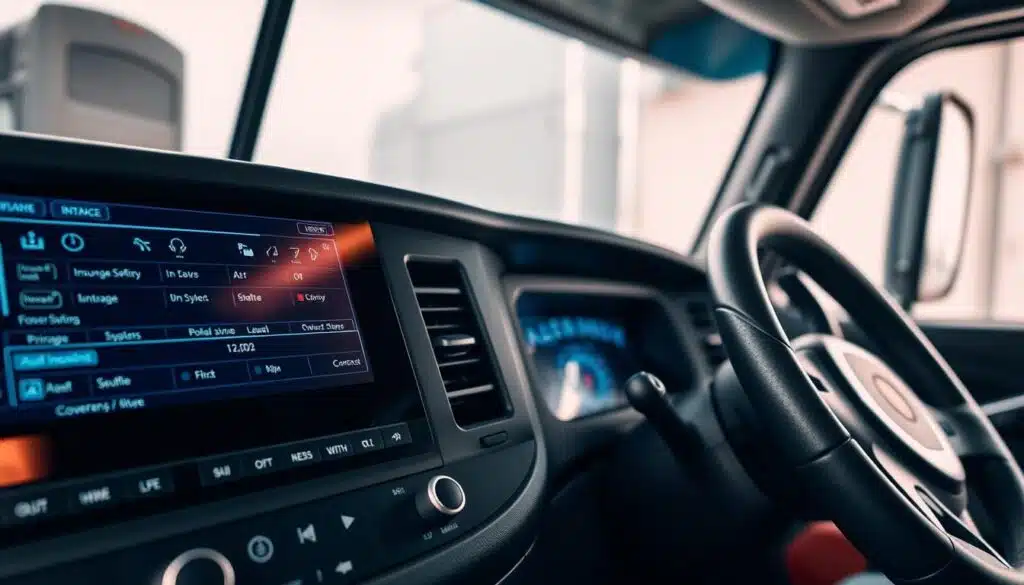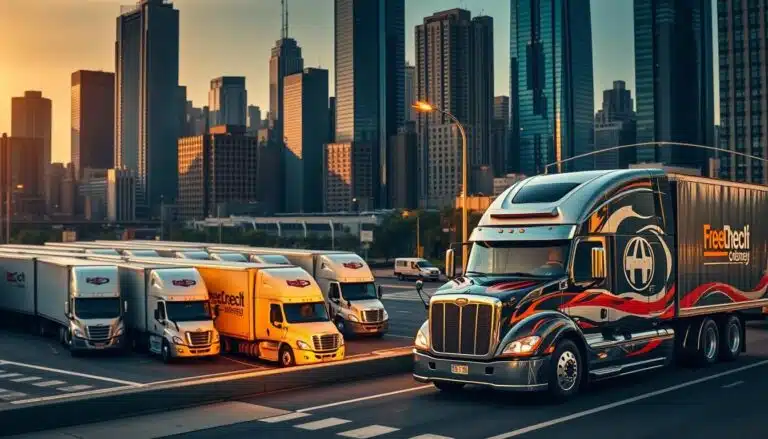Running a successful trucking business means making smart choices about protection. One of the most important decisions involves how you cover your assets. Understanding the core difference between two main coverage models is crucial for your bottom line and operational ease.
Your choice largely depends on the scale of your operations. Are you an owner-operator with a couple of rigs, or do you manage a larger group of vehicles? Each model offers distinct advantages. A single policy for multiple units can simplify management. Separate plans for each truck provide greater customization.
This guide will help you compare these approaches. We will explore cost structures, administrative demands, and coverage flexibility. The goal is to help you select the option that best fits your specific needs and growth plans.
Key Takeaways
- The number of vehicles you operate is the primary factor in choosing a coverage model.
- Managing one policy for multiple units often leads to significant cost savings.
- Separate plans allow for highly tailored protection for each truck.
- Your business’s growth projections should influence your decision.
- Administrative capacity is a key consideration for managing your chosen plan.
- Both options provide essential protection for your drivers, cargo, and business assets.
- The right choice balances cost, control, and convenience for your operation.
Understanding the Basics of Truck Insurance
A solid foundation in commercial vehicle protection is essential for making an informed decision for your business. This type of policy is not optional; it is a legal requirement for operating in the trucking industry. It safeguards you from financial losses due to accidents, cargo issues, and other liabilities.
Commercial vehicle coverage primarily comes in two forms. Your choice depends on how many rigs you operate.
- Fleet Policy: This covers multiple vehicles under a single contract. It is designed for businesses with several trucks.
- Individual Policy: This provides a separate plan for each truck. It offers tailored protection for owners with one or a few vehicles.
An Overview of Commercial Truck Insurance
The definition of a fleet can vary. Some insurance companies consider two vehicles a fleet. Others may require five or more. This flexibility means you should check with providers to see if you qualify.
Key Differences Between Fleet and Individual Policies
The main difference lies in management. A fleet policy groups all your vehicles under one umbrella. This means one renewal date and one set of terms.
Individual policies are handled separately. Each truck gets its own underwriting and premium. This allows for highly specific coverage based on each vehicle’s use and driver.
Fleet Insurance vs Individual Truck Insurance: Key Considerations
Choosing between comprehensive group plans and customized individual protection involves weighing distinct operational benefits. Your business size and management style determine which approach works best.
Advantages of Group Coverage
Group protection delivers significant administrative benefits. You manage one policy instead of multiple separate contracts.
Key advantages include:
- Simplified management with single renewal dates
- Uniform protection across all your vehicles
- Reduced paperwork through centralized administration
Bulk purchasing power often lowers your per-vehicle costs. Insurance companies typically offer volume discounts for larger operations.
Potential Drawbacks and Limitations
Group plans may lack customization options for specific needs. Specialized vehicles might require different protection levels.
Risk pooling can affect your entire operation. One high-claim vehicle might increase premiums for all units.
Consider these limitations when your vehicles have varied operational requirements. The right choice balances efficiency with flexibility.
When Fleet Insurance Makes Sense
The tipping point for considering consolidated coverage typically arrives when your operation grows beyond five commercial trucks. This threshold unlocks significant advantages for businesses managing multiple units.
Simplified Management Across Multiple Vehicles
Handling one policy instead of numerous individual contracts transforms your administrative workflow. You eliminate the complexity of tracking different renewal dates and varying terms.
Centralized administration means fewer documents to manage and reduced paperwork. Your team can focus on core operations rather than insurance coordination.
Cost Savings and Bulk Discounts
Volume purchasing power delivers substantial financial benefits. Insurers typically offer reduced per-vehicle premiums for covering multiple units under one agreement.
These bulk discounts often range from 10-25% compared to individual policies. The savings compound as you add more fleet vehicles to your operation.
Your business maximizes value when all units serve similar functions. Standardized safety protocols align perfectly with unified policy terms.
When Individual Truck Insurance is the Better Choice
Single-vehicle protection shines for operations with limited commercial units. When you manage just one or two trucks, separate plans often deliver superior value and flexibility.

Customization and Flexible Coverage Options
Individual policies allow precise tailoring for each vehicle’s unique needs. You can select specific liability limits and deductibles based on each truck’s usage.
This approach works perfectly when your vehicles serve different purposes. One might haul hazardous materials while another handles local deliveries.
Ideal for Owner-Operators and Small Fleets
Small business owners benefit from the granular control these plans offer. You maintain independence to shop for the best rates for each vehicle.
Clean driving records receive proper recognition with individual policies. Low-risk vehicles qualify for preferred rates without being averaged with higher-risk units.
| Scenario | Individual Policy Advantage | Fleet Policy Advantage |
|---|---|---|
| 1-2 vehicles | Customized coverage per unit | Limited cost savings |
| Mixed vehicle types | Tailored protection levels | Standardized terms |
| Frequent vehicle changes | Easy policy adjustments | Complex administration |
This approach maximizes value for operations with diverse needs. It ensures each truck receives exactly the protection it requires.
Essential Coverage and Compliance Requirements
Meeting federal and state insurance mandates is non-negotiable for commercial vehicle operators. Your business must maintain specific protection levels to operate legally. Understanding these essential requirements protects you from severe penalties.
Mandated U.S. Insurance Regulations
Federal regulations set baseline protection standards for interstate commerce. California requires minimum $750,000 liability coverage for semi-trucks. Many states follow similar minimum requirements.
Higher limits apply when transporting hazardous materials. You risk fines, vehicle impoundment, or business shutdown for non-compliance. Continuous verification of your coverage is essential.
Liability, Cargo, and Physical Damage Coverage
Liability protection forms your foundational insurance requirement. This coverage handles property damage and bodily injury claims. Your policy must meet or exceed state minimums.
Physical damage coverage protects your vehicle from collisions, theft, and vandalism. Cargo insurance becomes mandatory when hauling goods for others. The type cargo you transport determines specific coverage needs.
Additional protections include medical payments and non-trucking liability. These fill important gaps in your primary policy. Proper coverage ensures complete financial protection for your operation.
Comparing Costs and Savings
Understanding the economic implications of different coverage models helps optimize your operational expenses. Your choice significantly impacts your bottom line and financial planning.
Before diving into specific numbers, consider how each approach structures premiums. The total outlay differs dramatically between consolidated and separate plans.
Evaluating Premiums and Discounts for Each Model
Group coverage typically offers lower per-vehicle rates through volume discounts. Insurers reduce prices by 10-30% when you cover five or more units. Larger operations see even deeper savings.
Your total budget appears higher with a single policy. But breaking down the expenses reveals significant per-truck savings. This approach eliminates multiple administrative costs.
Separate plans allow precise pricing based on each vehicle’s characteristics. Newer trucks with safety features command better rates. Problem vehicles face higher premiums that aren’t averaged across your operation.
You can reduce expenses with either model through safety programs and telematics. Insurance companies reward low claims history with premium discounts. Multi-policy bundling creates additional savings opportunities.
Always compare quotes from multiple providers. Rates vary based on your specific operation, cargo types, and driver records. Personalized quotes ensure accurate cost comparisons for your business.
Operational and Policy Management Benefits
Effective management of your commercial vehicle operation extends beyond daily logistics to include strategic policy oversight. The right approach transforms insurance from a compliance requirement into a competitive advantage.
Centralized systems handle all your units under one contract. This eliminates the complexity of tracking multiple renewal dates and payment schedules.
Streamlined Administration and Renewals
You gain tremendous efficiency when policy management consolidates administrative tasks. One annual renewal replaces constant coordination throughout the year.
Your drivers benefit from consistent procedures across all vehicles. They know exactly what coverage protects them and how to report incidents.
“Standardized processes reduce confusion during stressful claim situations and improve response times.”
Risk Management and Claims Handling
Claims management becomes significantly more efficient with a unified approach. You report all incidents to one carrier and work with familiar adjusters.
Many companies provide telematics platforms that monitor vehicle locations and driver behaviors. This data supports both operational decisions and risk mitigation strategies.
| Management Aspect | Multiple Individual Policies | Consolidated Policy Approach |
|---|---|---|
| Renewal Dates | Spread throughout the year | Single annual date |
| Claims Reporting | Different procedures per carrier | Standardized system |
| Risk Assessment | Vehicle-by-vehicle basis | Holistic operation view |
| Driver Training | Varied requirements | Consistent standards |
You establish better control when working with one provider who understands your complete business model. This enables strategic discussions about coverage optimization based on your specific needs.
Conclusion
The path to securing the best commercial vehicle coverage begins with understanding your business’s unique characteristics and growth trajectory. There’s no universal solution that fits every operation.
Your decision hinges on several key factors. The number of rigs you operate, your administrative capacity, and desired level of control all influence which approach serves your needs best. Consolidated plans work well for multiple vehicles seeking streamlined management.
Separate policies offer superior customization for operations with diverse requirements. They provide granular control over coverage terms for each specific truck in your business.
Ultimately, comparing quotes from specialized providers ensures you make an informed choice. The right protection balances cost efficiency with operational effectiveness for long-term success.


